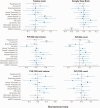Retinal microvascular phenotypes can track small vessel disease burden and CPAP treatment effectiveness in obstructive sleep apnea
- PMID: 39487754
- PMCID: PMC11563513
- DOI: 10.1177/0271678X241291958
Retinal microvascular phenotypes can track small vessel disease burden and CPAP treatment effectiveness in obstructive sleep apnea
Abstract
Optical coherence tomography angiography (OCT-A) retinal imaging enables in vivo visualization of the retinal microvasculature that is developmentally related to the brain and can offer insight on cerebrovascular health. We investigated retinal phenotypes and neuroimaging markers of small vessel disease (SVD) in individuals with obstructive sleep apnoea (OSA). We enrolled 44 participants (mean age 50.1 ± SD 9.1 years) and performed OCT-A imaging before and after continuous positive airway pressure (CPAP) therapy. Pre-treatment analyses using a generalized estimating equations model adjusted for relevant covariates, revealed perivascular spaces (PVS) volume in basal ganglia associated with greater foveal vessel density (fVD) (p-value < 0.001), and smaller foveal avascular zone area (p-value = 0.01), whereas PVS count in centrum semiovale associated with lower retinal vessel radius (p-value = 0.02) and higher vessel tortuosity (p-value = 0.01). A reduction in retinal vessel radius was also observed with increased OSA severity (p-value = 0.05). Post-treatment analyses showed greater CPAP usage was associated with a decrease in fVD (p-value = 0.02), and increased retinal vessel radius (p-value = 0.01). The findings demonstrate for the first time the potential use of OCT-A to monitor CPAP treatment and its possible impact on both retinal and brain vascular health.
Keywords: CPAP treatment; OCT-angiography; OSA; Retinal imaging; SVD burden.
Conflict of interest statement
Declaration of conflicting interestsThe author(s) declared no potential conflicts of interest with respect to the research, authorship, and/or publication of this article.
Figures




References
-
- Song TJ, Park JH, Choi KH, et al.. Moderate-to-severe obstructive sleep apnea is associated with cerebral small vessel disease. Sleep Med 2017; 30: 36–42. - PubMed
MeSH terms
LinkOut - more resources
Full Text Sources
Research Materials

